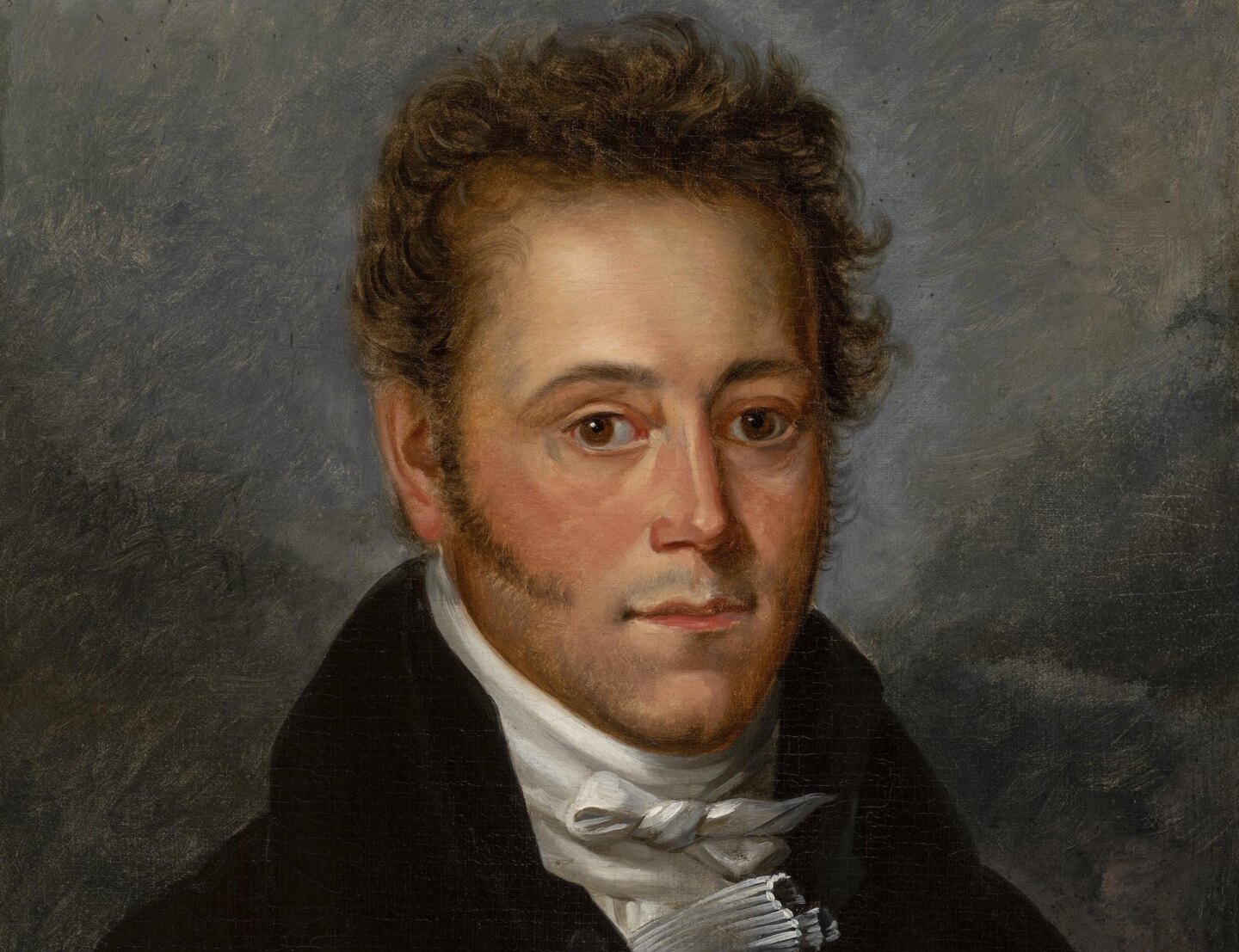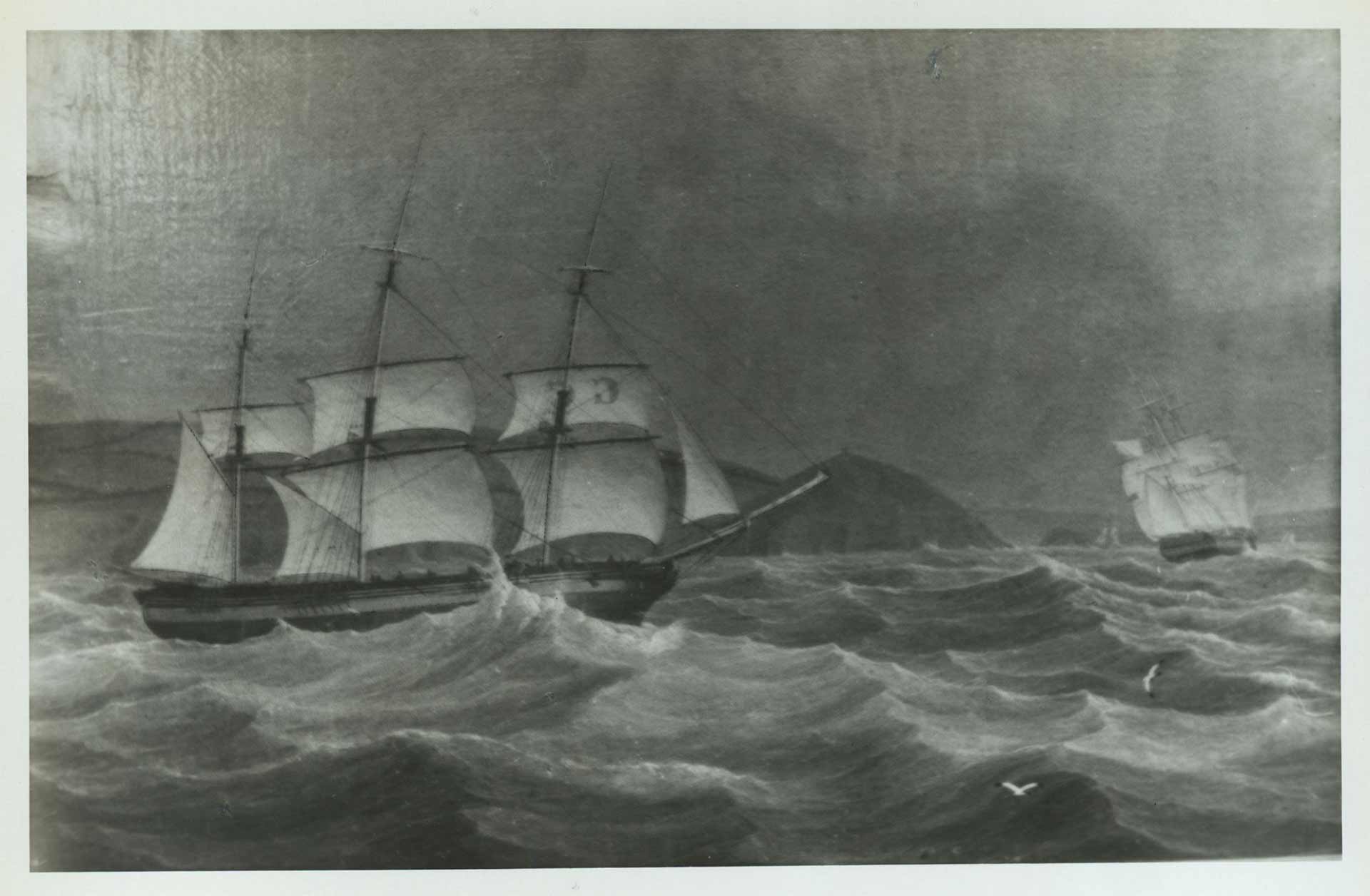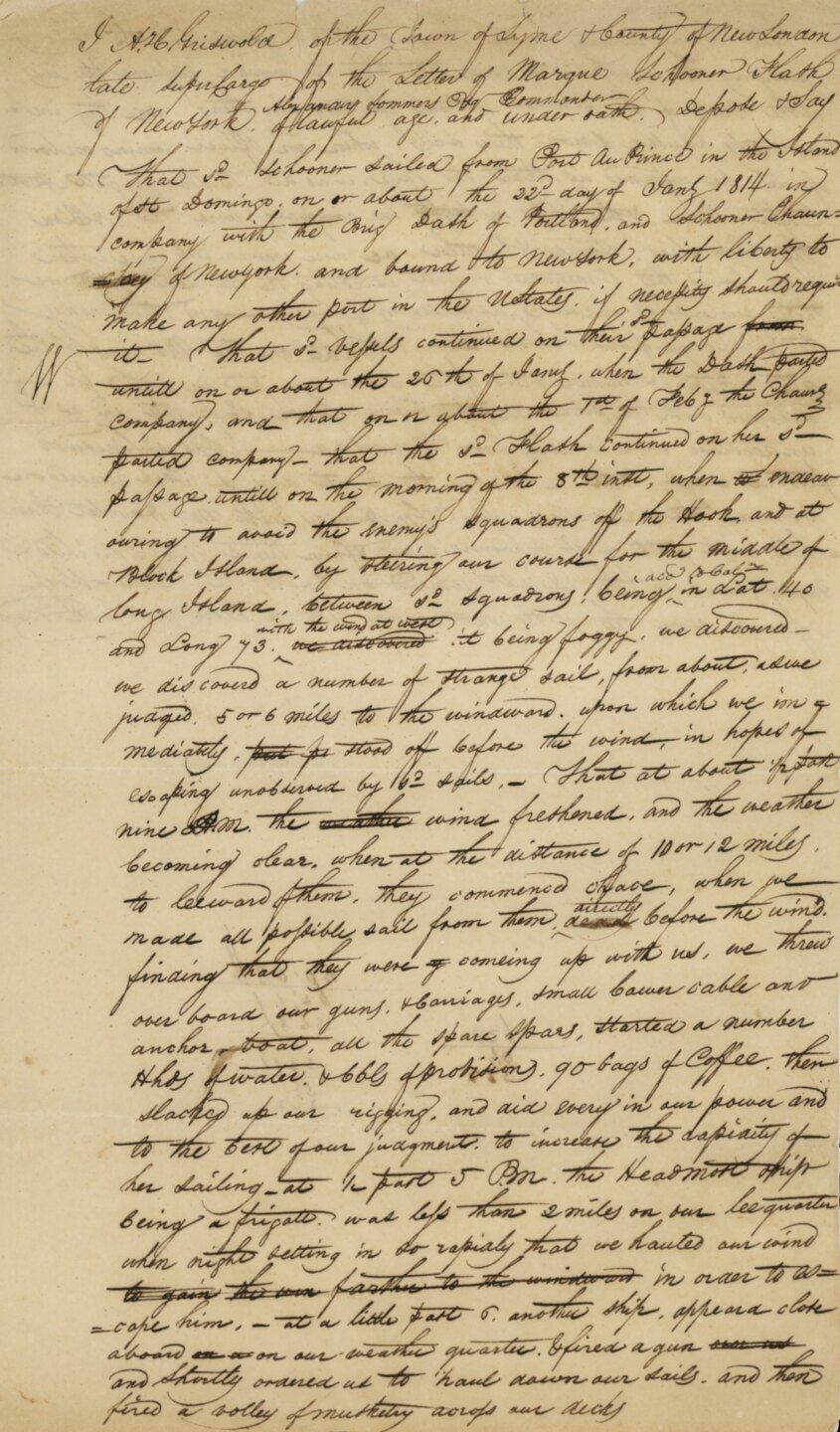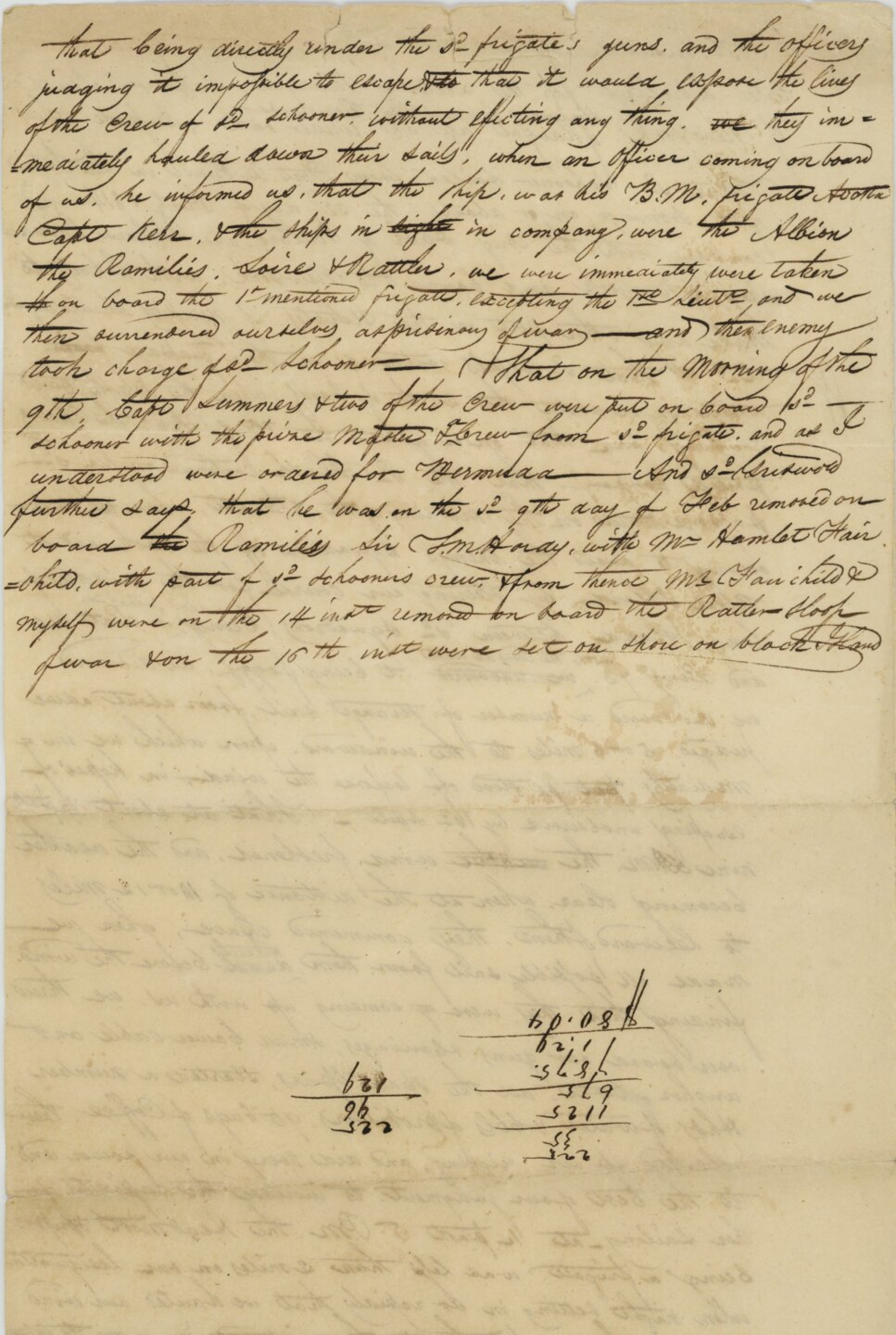
Transcribed by John E. Noyes
Featured Image: Probably Gustave de Galard (1779–1841), Captain Augustus Henry Griswold (detail), ca. 1820, Oil on canvas. Florence Griswold Museum, Gift of Gay Wilmerding, 2020.16.1
Early in its history, the United States relied heavily on privateers during wartime to supplement its small navy. Privateers were private vessels, commissioned by the U.S. government to capture ships that ran blockades, carried contraband of war, or engaged in enemy service. A captured vessel was brought before a U.S. court that determined whether the ship was a lawful “prize.” If it was, the prize court authorized the sale of the vessel and its cargo, with the proceeds shared by the U.S. government and the privateer’s captain, crew, vessel owner, and other investors. Other countries, including Great Britain and France, also captured prizes of war. Lyme residents had connections to privateering as ship builders, ship owners, investors, ship captains, and crew members.
In the deposition transcribed below,[1] Augustus Henry Griswold (1789–1836), the eldest son of Connecticut Governor Roger Griswold and Fanny Rogers Griswold, details the 1814 capture of the privateer Flash off Long Island by a faster, larger, and more heavily armed British frigate. The Flash was more than a privateer: she also transported goods to and from the Caribbean. Griswold, then 25, served as the ship’s supercargo, overseeing the cargo owner’s interests, supervising the sale of the cargo at the port of destination, and purchasing merchandise for shipment back to the United States. After the British captured the Flash on her return voyage to New York, they briefly held Griswold as a prisoner of war, releasing him on Block Island after a week’s captivity.
Ship “Acasta” Captained by Augustus Henry Griswold later in his career. Photograph. Lyme Historical Society Archives at the Florence Griswold Museum
After his early voyages as a supercargo, Augustus Henry Griswold had a distinguished career as a ship captain in the trans-Atlantic trade. In 1816, two years after his release from British captivity, he took command of the brig Cornelia. Griswold later served as captain of the ships Comet, Cincinnatus, Acasta (not to be confused with the British frigate Acasta referred to in the deposition below), Cambria, Samuel Robertson, and Ann Maria.[2] These vessels carried passengers, cargo, and mail from New York to London and other distant ports. After 29 years at sea, he retired to his native Black Hall where he taught for a few years at the Black Hall district school.
Here is Griswold’s deposition detailing the events of February 7-8, 1814:
I, A.H Griswold of the Town of Lyme & County of New London late SuperCargo of the Letter of Marque Schooner Flash of NewYork, Alexander Sommers Esq Commander, of lawful age, who under oath, depose & say
That sd schooner sailed from Port Au Prince in the Island of St Domingo, on or about the 22d day of Jany 1814 in Company with the Brig Dash of Portland, and schooner Chauncey of NewYork, and bound to NewYork, with liberty to make any other port in the UStates, if necessity should require it – That sd vessels continued on their sd passage until on or about the 26th of Jany, when the Dash parted company, and that on or about the 7th th of Feby the Chauncey parted company – that the sd Flash continued on her sd passage, until on the morning of the 8th inst, when endeavouring to avoid the enemy’s squadrons off the Hook and at Block Island, by steering our course for the middle of Long Island, between sd squadrons, being acd to caln in Lat. 40 and Long 73 with the wind at west, it being foggy, we discovered – we discovered a number of strange sail from about, as we judged, 5 or 6 miles to the windward, upon which we immediately stood off before the wind, in hopes of escaping unobserved by sd sails. – That at about ½ of nine AM. the wind freshened, and the weather becoming clear, when at the distance of 10 or 12 miles, to leeward of them, they commenced chase, when we made all possible sail from them, directly before the wind, finding that they were comeing up with us, we threw over board our guns, & carriages, small lower cable and anchor, boat, all the spare spars, started a number Hhds of water, & bbls of provisions, 90 bags of Coffee, then slacked up our rigging, and did every in our power and to the best of our judgment to increase the capacity of her sailing – at ½ past 5 P.M. the Headmost ship being a frigate was less than 2 miles on our lee quarter when night setting in so rapidly that we hauled our wind in order to escape him. – at a little past 6, another ship, appeard close aboard on our weather quarter, & fired a gun and shortly ordered us to haul down our sails, and then fired a volley of musketry across our decks
that being directly under the sd frigate’s guns, and the officers judging it impossible to escape & that it would expose the lives of the crew of sd schooner, without effecting any thing, they immediately hauled down their sails, when an officer coming on board of us, he informed us, that the ship, was his B.M. frigate Acasta Capt Kerr, & the ships in in company, were the Albion the Ramilies, Loire & Rattler, we were immediately were taken on board the 1st mentioned frigate, excepting the 1st Lieutn, and we then surrendered ourselves as prisoners of war – and the enemy took charge of sd Schooner – That on the morning of the 9th Capt Summers & two of the crew were put on board sd schooner with the prize master & a Crew from sd frigate, and as I understood were ordered for Bermuda – And sd Griswold further says that he was on the sd 9th day of Feb removed on board the Ramilies Sir T.M. Hardy, with Mr Hamlet Fairchild with part of sd schooners crew & from thence Mr Fairchild & myself were on the 14 inst removed on board the Rattler Sloop of war & on the 16th were set on shore on block Island.
[1] Griswold Family Papers, Box 1, File 7, Lyme Historical Society Archives, Florence Griswold Museum.
[2] See Thomas A. Stevens, Connecticut River Master Mariners (1979), p. 15.








